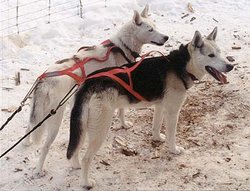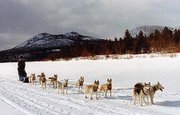Seppala Siberian Sleddog
Dogs
Seppala Siberian Sleddog
| Seppala Siberian
Sleddog |

Two Seppala Siberian Sleddog lead dogs
|
| Alternative names |
| |
| Country of origin |
|
Canada |
| Common nicknames |
| |
| Classification and breed standards |
| Not recognized by any major kennel club |
| This breed of dog is
extinct |
| Notes |
| |
A rare
working dog
breed,
the Seppala Siberian Sleddog was developed for the purpose of pulling a
sled in cold
country. It is a moderate-sized
dog averaging 40 to
50 pounds (18 to 23 kg) weight and 22 or 23 inches (56 to 58 cm) height. Colours
and markings are considered of little importance; eyes may be brown, blue or any
combination of the two colours. Seppalas are active and energetic but very
docile and trainable.
Seppalas show a primitive canine type, never having been bred or selected for
beauty or for the show ring. The breed shares its ancestral base with the
Siberian Husky and for half a century shared the same registry with that
breed, but was bred always exclusively as a working
sleddog breed
in its own right and kept apart from show bloodlines. In the late 1990s, it was
recognised by Canadian agricultural authorities as a new “evolving breed” and in
2002 a similar separate breed initiative was started in the USA.
History
Bred by the legendary dog driver
Leonhard Seppala from dogs imported into
Alaska from
eastern Siberia,
the Seppala Siberians became famous in Alaska for their domination of the
All-Alaska Sweepstakes distance race in the period from 1914 to 1917. Later
they became popular in
New
England when Seppala raced there and ran a kennel in Poland Spring, Maine.
In 1939 the last Siberia imports, along with several of Seppala’s dogs,
became the breed foundation for the “Siberian Huskie” in Canada. The Canadian
Seppala Kennels of Harry R. Wheeler in St. Jovite Station, Quebec, developed and
bred Seppala Siberians until 1950 in genetic isolation from the developing
Siberian Husky breed in the USA, which gradually became oriented more and more
toward dog
shows. A succession of Seppala breeders kept the strain alive through the
1950s and 1960s.
In 1963, the third Seppala Kennels, run by C. S. MacLean and J. D. McFaul in
Maniwaki, Quebec,
closed without a successor kennel and by 1969 the unique
Leonhard Seppala strain faced extinction. It was primarily saved by the
timely action of two breeders: Markovo Kennels in Canada and Seppineau Kennels
in the USA. The bloodline was then carried forward and developed as a serious
mid-distance racing sleddog by Douglas W. Willett of Sepp-Alta Kennels in the
state of Utah. The
pure, original Seppala bloodlines are rare but found in small numbers in several
Canadian provinces, the main population occurring in the
Yukon Territory.
The Seppala Siberian Sleddog Project that was started in 1993 by the
protagonists of the Markovo rescue effort won Agriculture Canada’s recognition
for Seppalas in July of 1997. The fourth historic Seppala Kennels in the Yukon
Territory carried the breeding forward. In July of 2002, Doug Willett undertook
a similar breed initiative through the
Continental Kennel Club’s registry in the USA.
 Team of Seppala Siberians
Team of Seppala Siberians
Characteristics
Seppalas of today differ markedly from many other Siberian Husky bloodlines
in physical appearance, being in general less flashily marked, longer in leg and
body length, and lighter in weight and physical build than some Siberian Husky
show dogs. Pure-strain Seppalas have dense, smooth coats of medium length with
an undercoat nearly as long as the guard hairs. Their ears are taller, set close
together and strongly erect; the "stop" of the head less well-defined than that
of Siberian Huskies. The tail is held high in a sickle curve over the back when
alert, never "snapped" flat to the back or curling down the flank. They tend to
be more trainable than other sled dogs and to be more highly bonded to their
owners. The Seppala Siberian Sleddog disposition is active, merry, and often
quite inquisitive, although sometimes showing great reserve with strangers. A
stable and serious temperament, neither nervous nor aggressive, is
characteristic. Natural, innate sleddog mentality is a primary characteristic of
Seppala dogs. Their nature is highly cooperative. They show great seriousness in
their work in harness.
Many Seppalas are pure white or buff and white. Others are very dark, black,
or charcoal grey with dark faces and white only on the feet and tail tip. There
are many varied shades of grey, brownish grey, and blue-grey. “Sable” reds with
black-tipped guard hairs and black noses occur, but the liver-nosed “copper”
phase seen in other lines of Siberian Huskies is unknown in pure Seppalas.
Agouti "wild type" coloration and piebald spotting are common.
Seppalas are known for their extremely smooth and well-coordinated gait and
for the consistency and strength with which they pull in harness. Although they
appear to the inexperienced eye to be rather small and lightly built for
sleddogs, actually they are far more efficient pullers than some larger northern
breeds. They are capable racing sleddogs, particularly in middistance events,
although perhaps not as speedy as world-class
Alaskan huskies or pointer-crossed hybrids.
Like other northern breeds, they shed their coats hugely once or twice a
year, cannot safely be allowed to run free off leash, and love to hunt small
game. They are generally robust and healthy, living twelve to sixteen years,
usually working well in harness up to ten or eleven years of age. Health issues
for the breed are those common to all northern breeds, such as
allergies,
cancer and eye
problems. They are highly efficient in their use of food, eating relatively
little but requiring very high-quality nutrition that is rich in animal protein,
animal fat, and fish oil.
The defining characteristics of the breed are its natural, primitive
appearance, its highly developed work ethic, and its affectionate, cooperative,
and highly bonded nature.
External links
Home | Up | Saarlooswolfhond | Saluki | Samoyed | Sapsali | Schipperke | Schnauzer | Scottish Terrier | Sealyham Terrier | Seppala Siberian Sleddog | Serbian Hound | Serbian Mountain Hound | Serbian Tricolour Hound | Shar Pei | Shetland Sheepdog | Shiba Inu | Shih Tzu | Shikoku | Shiloh Shepherd Dog | Siberian Husky | Skye Terrier | Sloughi | Small Munsterlander | Smooth Collie | Soft-Coated Wheaten Terrier | South Russian Ovtcharka | Spanish Mastiff | Spinone Italiano | Springer Spaniel | St. Bernard | Stabyhoun | Staffordshire Bull Terrier | Standard Schnauzer | Swedish Vallhund
Dogs, made by MultiMedia | Free content and software
This guide is licensed under the GNU
Free Documentation License. It uses material from the Wikipedia.
|




